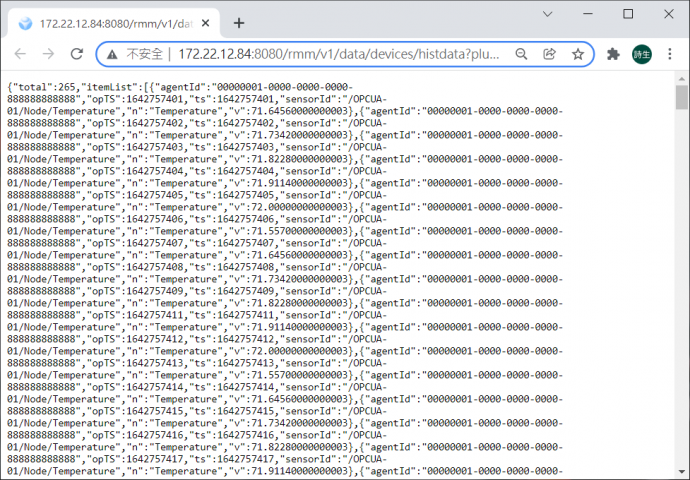|
|
| Line 217: |
Line 217: |
| | | | |
| | <br/><br/> | | <br/><br/> |
| − |
| |
| − |
| |
| − | = Release =
| |
| − |
| |
| − | <span style="font-size:larger;">This is an overview that displays OPC-UA Service versions and some stats and numbers for each release.</span>
| |
| − |
| |
| − | {| border="1" cellpadding="1" cellspacing="1" style="width: 1292px;"
| |
| − | |-
| |
| − | | style="width: 47px; text-align: center;" | <span style="font-size:larger;">Index</span>
| |
| − | | style="width: 63px; text-align: center;" | <span style="font-size:larger;">Version</span>
| |
| − | | style="width: 85px; text-align: center;" | <span style="font-size:larger;">Date</span>
| |
| − | | style="width: 78px; text-align: center;" | <span style="font-size:larger;">Platform</span>
| |
| − | | style="width: 109px; text-align: center;" | <span style="font-size:larger;">OS</span>
| |
| − | | style="width: 587px; text-align: center;" | <span style="font-size:larger;">Release Note</span>
| |
| − | | style="width: 286px; text-align: center;" | <span style="font-size:larger;">Installer</span>
| |
| − | |-
| |
| − | | style="width: 47px; text-align: center;" | <span style="font-size:larger;">1</span>
| |
| − | | style="width: 63px; text-align: center;" | <span style="font-size:larger;">v2.0.1</span>
| |
| − | | style="width: 85px; text-align: center;" |
| |
| − | <span style="font-size:medium;">2020/1/03</span>
| |
| − |
| |
| − | | style="width: 78px; text-align: center;" | <span style="font-size:larger;">x86_64 CPU</span>
| |
| − | | style="width: 109px; text-align: center;" | <span style="font-size:larger;">Windows</span>
| |
| − | | style="width: 587px;" |
| |
| − | <span style="font-size:medium;">1. Support Multiple OPCUA server.</span>
| |
| − |
| |
| − | <span style="font-size:medium;">2. Support Anonymous, Username/Password</span>security check.</span>
| |
| − |
| |
| − | <span style="font-size:medium;">3. Support individual node access interval configuration.</span>
| |
| − |
| |
| − | <span style="font-size:medium;">4. Configurable node alias.</span></span>
| |
| − |
| |
| − | <span style="font-size:larger;">[file://eossfs/ESS-Release/EdgeSense/Software/OPCUA_Client/Windows/2.0.1 OPCUA_Client_for_Windows_ReleaseNote_2.0.1.txt]</span>
| |
| − |
| |
| − | | style="width: 286px; text-align: center;" | <span style="font-size:larger;">[file://eossfs/ESS-Release/EdgeSense/Software/OPCUA_Client/Windows/2.0.1 device-opcua-client-2.0.1.exe]</span>
| |
| − | |-
| |
| − | | style="width: 47px; text-align: center;" | <span style="font-size: 15.6px;">2</span>
| |
| − | | style="width: 63px; text-align: center;" | <span style="font-size:larger;">v2.0.1</span>
| |
| − | | style="width: 85px; text-align: center;" |
| |
| − | <font size="3">Coming soon</font>
| |
| − |
| |
| − | | style="width: 78px; text-align: center;" |
| |
| − | <span style="font-size:larger;">ARM</span>
| |
| − |
| |
| − | <span style="font-size:larger;">CPU</span>
| |
| − |
| |
| − | | style="width: 109px; text-align: center;" | <span style="font-size: 15.6px;">Debian</span>
| |
| − | | style="width: 587px;" |
| |
| − | <span style="font-size:medium;">1. Support Multiple OPCUA server.</span>
| |
| − |
| |
| − | <span style="font-size:medium;">2. Support Anonymous, Username/Password security check.</span>
| |
| − |
| |
| − | <span style="font-size:medium;">3. Support individual node access interval configuration.</span>
| |
| − |
| |
| − | <span style="font-size:medium;">4. Configurable node alias.</span></span> [file://eossfs/ESS-Release/EdgeSense/Software/OPCUA_Client/Debian OPCUA_Client_for_Debian_ReleaseNote_2.0.1.txt]</span>
| |
| − |
| |
| − | | style="width: 286px; text-align: center;" | <span style="font-size:larger;">[file://eossfs/ESS-Release/EdgeSense/Software/OPCUA_Client/Debian device-opcua-client-2.0.1-Debian_9.9-rk3399.run]</span>
| |
| − | |-
| |
| − | | style="width: 47px; text-align: center;" | <span style="font-size:larger;">3</span>
| |
| − | | style="width: 63px; text-align: center;" | <span style="font-size:larger;">v2.0.2</span>
| |
| − | | style="width: 85px; text-align: center;" |
| |
| − | <span style="font-size:medium;">2020/3/31</span>
| |
| − |
| |
| − | | style="width: 78px; text-align: center;" | <span style="font-size:larger;">x86_64 CPU</span>
| |
| − | | style="width: 109px; text-align: center;" | <span style="font-size:larger;">Windows</span>
| |
| − | | style="width: 587px;" |
| |
| − | <span style="font-size:medium;">1. Support Web UI configuration.</span>
| |
| − |
| |
| − | <span style="font-size:medium;">2. Use AdvSC to control service life cycle.</span>
| |
| − |
| |
| − | <span style="font-size:larger;">[file://file://eossfs/ESS-Release/EdgeSense/Release/Windows/OPCUA_Client OPCUA_Client_for_Windows_ReleaseNote_2.0.2.txt]</span>
| |
| − |
| |
| − | | style="width: 286px; text-align: center;" | <span style="font-size:larger;">[file://eossfs/ESS-Release/EdgeSense/Release/Windows/OPCUA_Client device-opcua-client-2.0.2.exe]</span>
| |
| − | |-
| |
| − | | style="width: 47px; text-align: center;" | <span style="font-size:larger;">4</span>
| |
| − | | style="width: 63px; text-align: center;" | <span style="font-size:larger;">v2.0.3</span>
| |
| − | | style="width: 85px; text-align: center;" |
| |
| − | <span style="font-size:medium;">Coming Soon</span>
| |
| − |
| |
| − | | style="width: 78px; text-align: center;" | <span style="font-size:larger;">x86_64 CPU</span>
| |
| − | | style="width: 109px; text-align: center;" | <span style="font-size:larger;">Windows</span>
| |
| − | | style="width: 587px;" |
| |
| − | <span style="font-size:medium;">1. Support write node data.</span>
| |
| − |
| |
| − | <span style="font-size:medium;">2. Support read array type node data.</span>
| |
| − |
| |
| − | <span style="font-size:larger;">[file://eossfs/ESS-Release/EdgeSense/Release/Windows/OPCUA_Client OPCUA_Client_for_Windows_ReleaseNote_2.0.3.txt]</span>
| |
| − |
| |
| − | | style="width: 286px; text-align: center;" | <span style="font-size:larger;">[file://eossfs/ESS-Release/EdgeSense/Release/Windows/OPCUA_Client device-opcua-client-2.0.3.exe]</span>
| |
| − | |}
| |
| − |
| |
| − | <span style="font-size:larger;">Above files are available at local server, please paste file's url in File Explorer to copy file. ([[EdgeSense_FAQ|How to access to EOSSFS file server]] )</span>
| |
Revision as of 02:53, 8 August 2023
Introduction
OPC Unified Architecture (OPC UA) is a machine to machine communication protocol for industrial automation developed by the OPC Foundation.
Features
EdgeSense OPC-UA Client aims to collect data from OPC-UA Server and control.
Feature:
How to
Installation
Windows:
1. Download OPC-UA Client for Windows from Release Table.
2. Double click the installer to launch the installer to install it to the machine.
Debian:
1. Download OPC-UA Client for Debian from Release Table.
2. Launch the installer to install it to the machine.
Prepare OPCUA Demo Server
Please follow below steps to setup OPCUA Demo Server:
1. Download Unified Automation C++ Demo Server from https://www.unified-automation.com/downloads/opc-ua-servers.html and install it to the server machine.
2. Launch UaCppServer from Windows Start Menu.
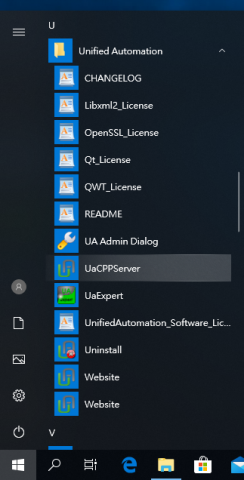

3. Information of OPCUA Demo Server, include Username/Password, Endpoint URL and Node IDs are shown in below.
| Username
|
Password
|
| root
|
secret
|
| Endpoint URL Format
|
opc.tcp://<Mancine Name or IP>:<Port>
|
| Endpoint URL for this Demo
|
opc.tcp://Protocol-Converter-GW:48010
|
| Node Nmae
|
Node ID
|
| AirConditioner_1.Humidity
|
ns=3;s=AirConditioner_1.Humidity
|
| AirConditioner_1.Temperature
|
ns=3;s=AirConditioner_1.Temperature
|
| AirConditioner_2.Humidity
|
ns=3;s=AirConditioner_2.Humidity
|
| AirConditioner_2.Temperature
|
ns=3;s=AirConditioner_2.Temperature
|
Config OPCUACLient Plugin
Please follow below steps to config OPCUAClient plugin to subscribe data from OPCUA Demo Server:
Step 1. Go to "Plug-ins" / Plugin Config to select OPCUAClient Plug-in

Setp 2. Click "+" to add OPCUA project

Setp 3. Edit new OPCUA Project
PROJECT NAME: Enter a project name in unique
ENDPOINT URL: Endpoint URL of OPCUA Server

SECURITY MODE: None / Sign
USER NAME: Account of OPCUA Server
PASSWORD: Password of OPCUA Server

Setp 4. Click "+" to add Sensor Node

Step 5. Edit Node Information
NODEID: Node ID you'd like to monitor
NODENAME: Node name you'd like to show
INTERVAL(SEC): Subscribe/update interval in seconds
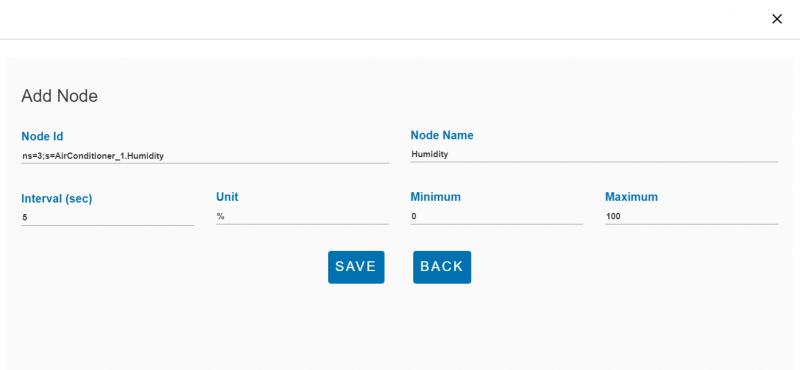
Step 6. Click "+" to add multiple nodes

Step 7. Click on delete icon to remove sensor node or click on edit icon to modify sensor node

Step 8. Click "Save" to complete node editing.
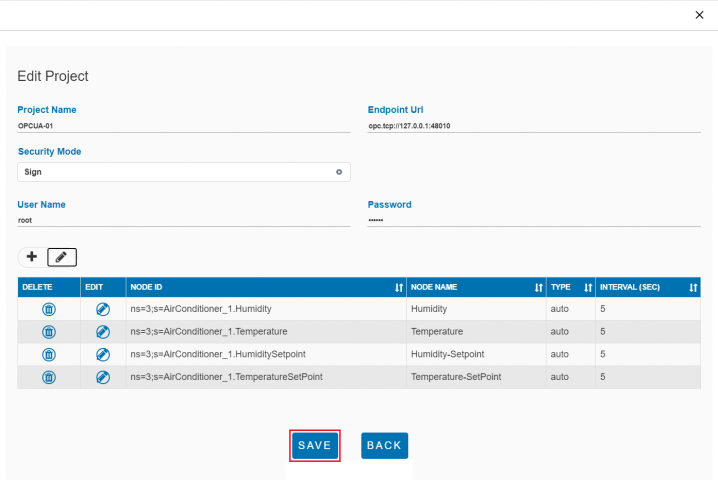
Setp 9. Click "Apply" to set and apply the new setting

Setp 10. You can monitor OPCUA sensor nodes at "Plugin List".
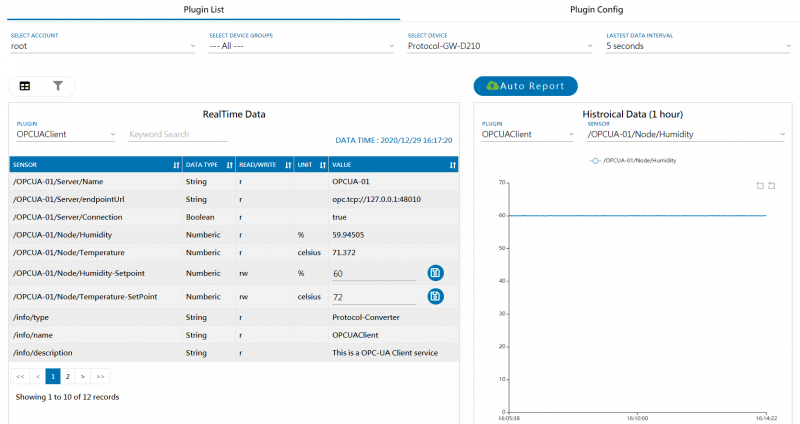
How to import plugin settings
Step 1. Click Import button from OPCUAClient Configuration
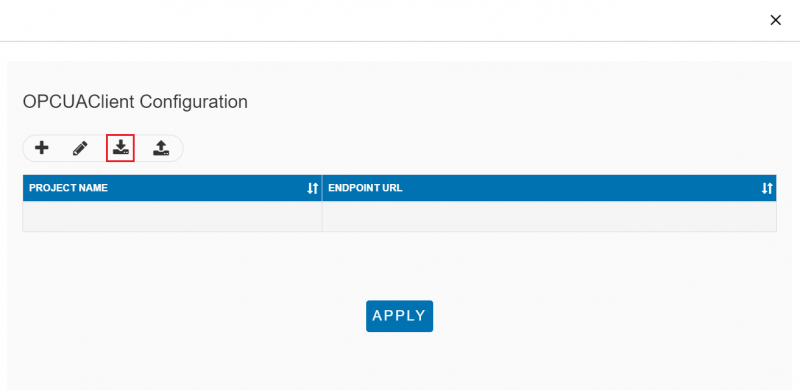
Step 2. Select target file you like to import
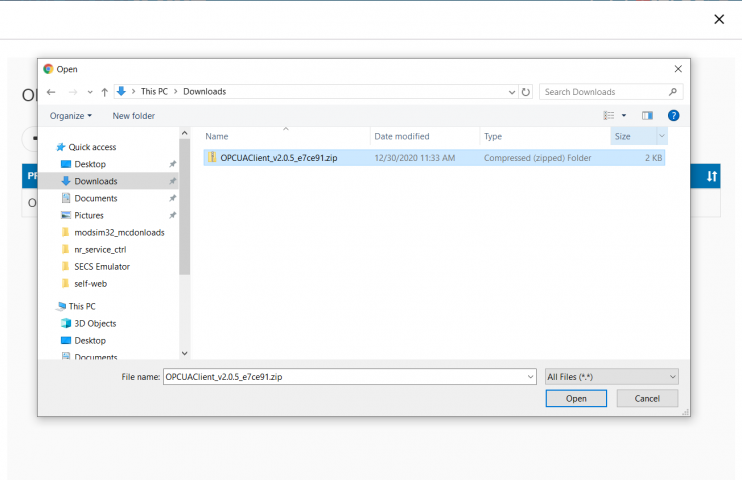
Import successful
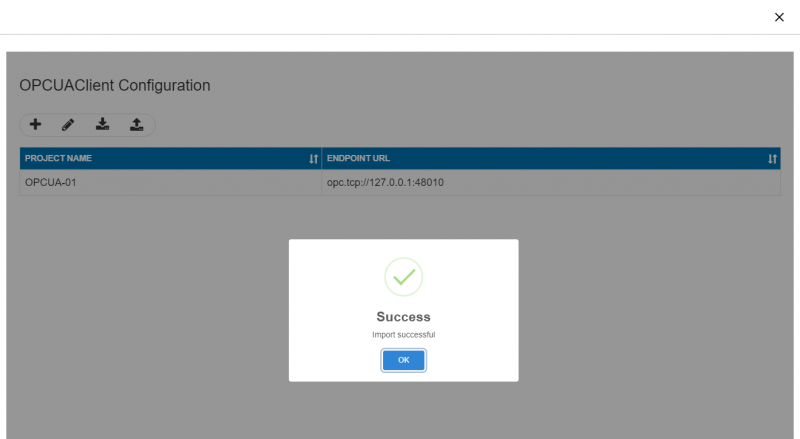
Step 3. Click APPLY to use imported configuration
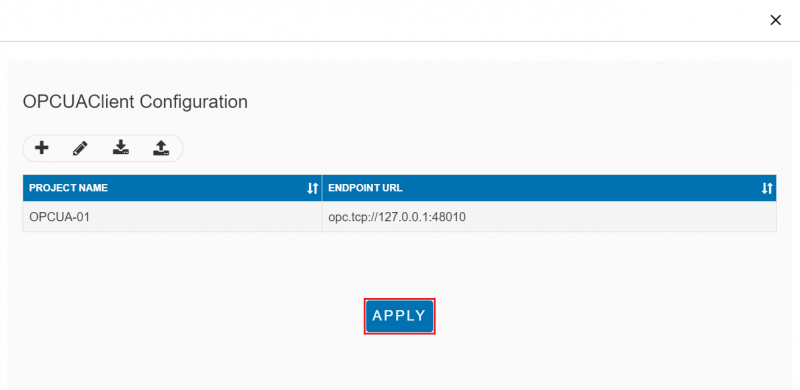
How to export plugin settings
Step 1. Click Export button from OPCUAClient Configuration
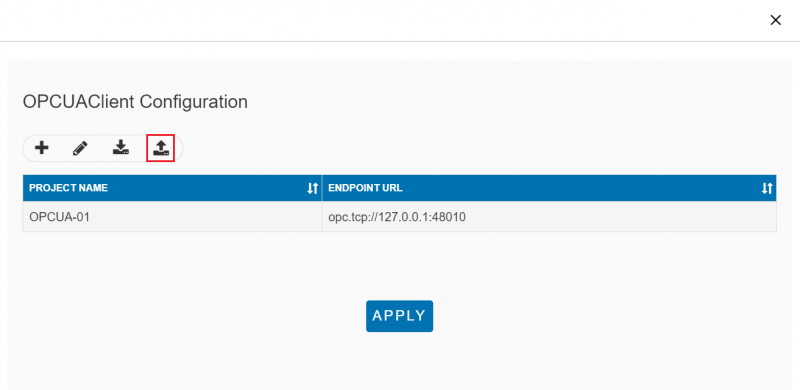
Step 2. Explore the exported file
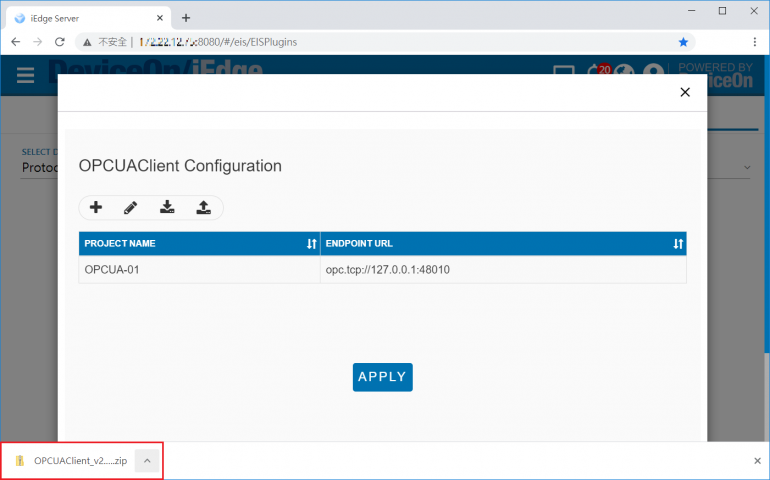
How to use RESTful API to get history data
Example:
http://172.22.12.84:8080//rmm/v1/data/devices/histdata?plugin=OPCUAClient&sensorId=/OPCUA-01/Node/Temperature&beginTs=2022-01-21%2017:30:00.000&endTs=2022-01-21%2017:35:00.000
